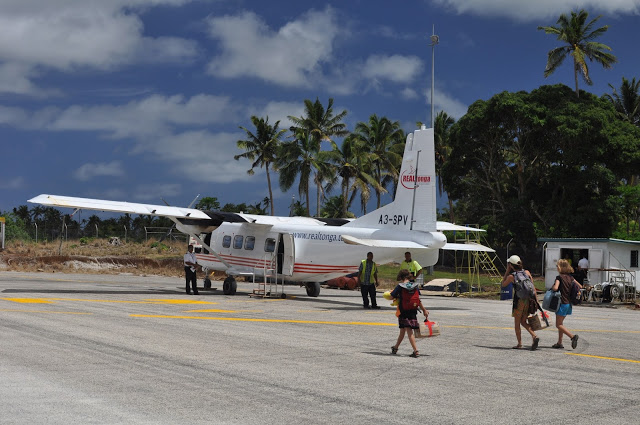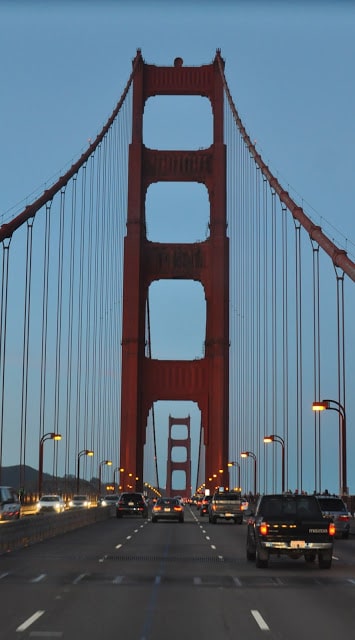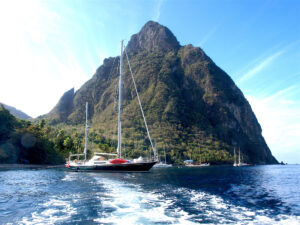
“You must be Eleanor and Frances!” the woman behind the REALTonga counter said as we approached, smiling at Eleanor and Frances. You know things have not gotten too big when a quick glance at the day’s passenger manifest makes it easy to deduce who passengers are as they walk into the terminal. I was still surprised when we checked in and got our boarding passes without ever showing identification. Our bags were weighed and tagged and taken from us. Then a roar overhead let us know that our plane had arrived.
REALtonga is the only Tongan airline. Their website features a picture of a generic, 737-sized jet streaking across the sky. But this is misleading. The REALtonga fleet is jet-free. The airline is almost 3 years old and began with only a single plane, a Xian MA60 that the Chinese government gifted to the Kingdom of Tonga and which the Kingdom of Tonga then leased to the burgeoning airline. But this arrangement didn’t pan out. The plane apparently has such a poor safety record that the New Zealand government issued a travel advisory to its citizens and withheld $10 million dollars in Tongan aid in a bid to get them to stop flying the thing. Within a year, the Tongan government returned the plane to China and the airline announced the purchase of two aging British Aerospace Jetstream 32 aircraft. That’s what I thought we’d be boarding.
“So what kind of plane is this?” I asked our Kiwi captain through the cockpit window after we landed in Nukuʻalofa, in southern Tonga.
“It’s a Harbin Y12, a Chinese knock-off of the Canadian Twin Otter.”

It would have been possible for us to fly from Neiafu to Nuku’alofa and then board a flight to Nadi, Fiji the same day, but we’d been warned. Apparently, REALtonga flights are VFR-only. This means they don’t fly during weather conditions—either at the departure point or the destination—that require pilots to use instruments. Also, during the seven weeks we were in Tonga, we heard several stories of folks whose travel plans were interrupted because of a mechanical issue with a REALtonga plane.
“You should really give yourself a day or so buffer; just plan an overnight in Nuku’alofa.”
So a month before leaving, we walked back to the high school in Neiafu, to the room that serves as the REALtonga office, and changed our flight.
“Great, so we leave a day sooner, same time. Is there any charge for changing our fare?”
“No, there is no charge.”
Once in Nuku’alofa, the REALtonga portion of our itinerary was over. We spent the night in a modern, New Zealand-company-owned hotel and the next afternoon boarded a Fiji Airways turbo-prop for a two-hour flight to Nadi (pronounced nahn-dee). There was again no taking off our shoes, no x-ray machine, no security check at all.
In Nadi, things got familiar. The terminal is modern and similar to any big-city airport terminal in the world. Burger King didn’t have their veggie burger available, but the friendly Fijians behind the counter came up with their own solution for me: a cheeseburger with all the trimmings, but substituting the meat patty for onion rings. Sold.
This time we did pass through all the customary security checkpoints and then boarded a clean wide-body A-330 for a 10-hour red-eye to Los Angeles. There, bleary-eyed and spent, we passed our two-hour layover lugging ourselves and stuff over to the Virgin America gate for a short flight up to San Francisco.
Driving across the Golden Gate Bridge, I realized that while it had seemed we’d been traveling for days, it was still two hours prior to the date and time that it was when we left Nuku’alofa. We’ll pay for that time gain on the way home in a few weeks, when we head back across the Date Line, back to Del Viento. I miss her bad.
In our twenties, we traded our boat for a house and our freedom for careers. In our thirties, we lived the American dream. In our forties, we woke and traded our house for a boat and our careers for freedom. And here we are. Follow along with the Roberston’s onboard Del Viento on their blog at www.logofdelviento.blogspot.com.








